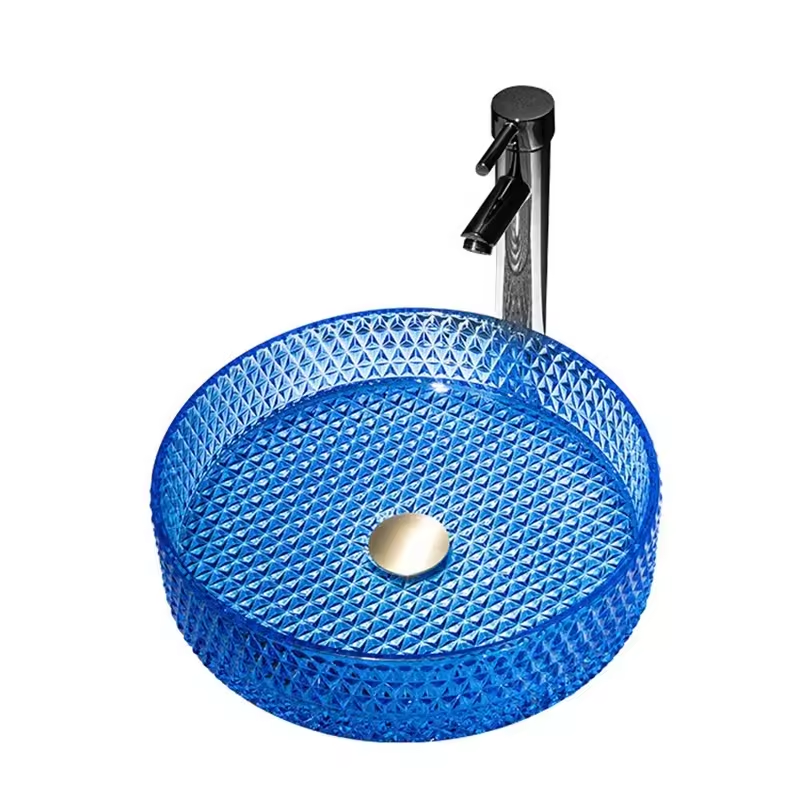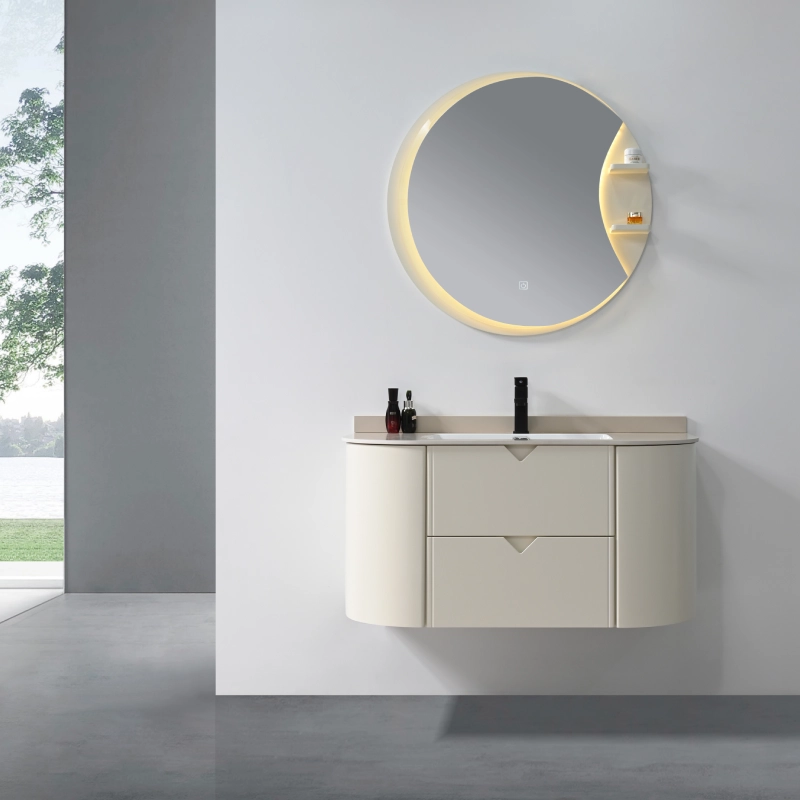The Best Materials for Bathroom Vanity Sinks
Choosing the right material for your bathroom vanity sink is crucial for both functionality and aesthetics. With a variety of materials available, each with its own set of benefits and drawbacks, it's important to make an informed decision. This guide will help you navigate through the most popular materials, how to choose the right one for your needs, and tips for maintaining them.
What Are the Most Popular Materials for Bathroom Vanity Sinks?
When selecting a bathroom vanity sink, the material plays a significant role in its performance and appearance. Here are the most popular materials:

Porcelain Bathroom Vanity Sinks
Porcelain is a classic choice for bathroom sinks, known for its smooth, glossy finish and durability. It's resistant to staining and scratching, making it a practical option for busy bathrooms. Porcelain sinks come in various shapes and sizes, fitting seamlessly into any bathroom design.

Glass Bathroom Vanity Sinks
Glass sinks are modern and stylish, offering a unique aesthetic appeal. They are available in clear, frosted, and colored options, allowing for customization to match your bathroom decor. While glass sinks require more careful maintenance to avoid scratches and smudges, their sleek look makes them a popular choice.

Stone Bathroom Vanity Sinks
Stone sinks, such as those made from marble, granite, or travertine, add a touch of luxury to any bathroom. These sinks are incredibly durable and each piece is unique, providing a one-of-a-kind look. However, they require regular sealing and maintenance to prevent stains and damage.

Resin Bathroom Vanity Sinks
Resin bathroom vanity sinks have become increasingly popular in modern bathroom design, offering a unique blend of aesthetic appeal and practical functionality. Made from a combination of natural stone and synthetic resins, these sinks provide a durable and versatile option for homeowners and designers alike.
How to Choose the Right Material for Your Bathroom Vanity Sink?
Selecting the right material involves considering several factors:
Durability
Evaluate how durable each material is and how it will hold up over time. Porcelain and metal are known for their durability, while glass and stone require more careful maintenance.
Maintenance
Consider how much time and effort you're willing to invest in maintaining the sink. Porcelain and metal sinks are easier to clean, while glass and stone need more attention to keep them looking their best.
Style
Your sink should complement the overall design of your bathroom. Glass and stone sinks offer unique aesthetic options, while porcelain and metal can blend into various styles seamlessly.
Budget
Budget is always a key consideration. Porcelain and glass sinks tend to be more affordable, while stone and custom metal sinks can be more expensive due to their unique materials and craftsmanship.
Compatibility
Ensure that the sink material you choose is compatible with your bathroom’s plumbing and vanity design. Some materials may require special fittings or supports.
What Are the Pros and Cons of Porcelain Bathroom Vanity Sinks?
Porcelain sinks are a popular choice for many homeowners. Here are the pros and cons:
Pros
Durability: Porcelain is highly durable and resistant to chips and cracks.
Low Maintenance: Easy to clean with standard bathroom cleaners.
Aesthetic Versatility: Available in various shapes and colors to match different styles.
Cost-Effective: Generally more affordable than other materials.
Cons
Weight: Porcelain sinks can be heavy, requiring sturdy vanity support.
Potential for Staining: While resistant, they can still stain if not cleaned regularly.
Limited Customization: Fewer options for unique or custom designs compared to materials like glass or stone.
How Do Glass Bathroom Vanity Sinks Compare to Other Materials?
Glass sinks are known for their striking appearance, but how do they stack up against other materials?
Aesthetic Appeal
Glass sinks are highly customizable, available in various colors, shapes, and finishes. They can serve as a focal point in your bathroom due to their unique and modern look.
Durability
While durable, glass sinks require more careful handling. They are prone to scratches and smudges, and can break if subjected to strong impacts.
Maintenance
Glass sinks need regular cleaning to maintain their clear, pristine look. Special glass cleaners are often required to prevent streaks and scratches.
Cost
Glass sinks can vary widely in price. Custom designs and high-quality glass can be more expensive, but standard options are often affordable.
Installation
Installing a glass sink requires careful consideration of plumbing and support structures, as they can be more delicate compared to porcelain or metal sinks.
What Makes Stone Bathroom Vanity Sinks a Luxurious Choice?
Stone sinks are synonymous with luxury and elegance. Here's why:
Unique Appearance
Each stone sink is unique, with natural variations in color and pattern. This uniqueness adds a high-end, bespoke feel to your bathroom.
Durability
Stone sinks are incredibly durable and can last a lifetime with proper care. They resist chipping and cracking better than other materials.
Aesthetic Versatility
Stone sinks come in various types (marble, granite, travertine), each offering a different look and feel. They can fit both contemporary and traditional designs.
Maintenance
Stone sinks require regular sealing to prevent stains and damage. They need to be cleaned with specific products to maintain their finish.
Cost
Stone sinks are often more expensive due to the cost of the raw material and the craftsmanship required to shape and finish them.
How to Maintain and Clean Different Bathroom Vanity Sink Materials?
Proper maintenance ensures that your bathroom vanity sink remains in top condition. Here are maintenance tips for different materials:
Porcelain Sinks
Cleaning: Use non-abrasive bathroom cleaners to avoid scratching the surface. Avoid harsh chemicals that can wear down the finish.
Stain Removal: For tough stains, a mixture of baking soda and water can be effective.
Glass Sinks
Cleaning: Use a glass cleaner or a mixture of vinegar and water to avoid streaks. Wipe with a soft cloth to prevent scratches.
Maintenance: Avoid placing heavy objects in or around the sink to prevent breakage.
Stone Sinks
Cleaning: Use pH-neutral cleaners specifically designed for stone. Avoid acidic or abrasive cleaners that can damage the surface.
Sealing: Regularly seal the stone to protect against stains and water damage. Frequency depends on the type of stone and usage.
Metal Sinks
Cleaning: Use mild dish soap and water for everyday cleaning. For tougher spots, a paste of baking soda and water can be effective.
Maintenance: Polish stainless steel sinks periodically to maintain their shine. Copper sinks should be regularly treated to prevent patina if a shiny appearance is desired.
What Are the Environmental Impacts of Various Bathroom Vanity Sink Materials?
Choosing an environmentally friendly sink material can reduce your ecological footprint. Here’s how different materials stack up:
Porcelain Bathroom Vanity Sinks
Sustainability: Porcelain is made from natural clay, which is abundant and sustainable. However, the manufacturing process can be energy-intensive.
Recyclability: Porcelain is not easily recyclable but is durable and long-lasting, reducing the need for frequent replacements.
Glass Bathroom Vanity Sinks
Sustainability: Glass is made from sand, which is also abundant. Recycled glass sinks are available and environmentally friendly.
Recyclability: Glass is highly recyclable, making it a good choice for eco-conscious consumers.
Stone Bathroom Vanity Sinks
Sustainability: Stone is a natural material, but quarrying and processing it can have significant environmental impacts.
Recyclability: Stone sinks can be repurposed or recycled, but their heavy weight can make this process challenging.
Metal Bathroom Vanity Sinks
Sustainability: Metals like stainless steel and copper are highly durable and can be sourced sustainably.
Recyclability: Metal sinks are highly recyclable, and scrap metal is often used to create new sinks.
How to Customize Your Bathroom Vanity Sink Material?
Customization allows you to create a unique bathroom sink that fits your style and needs. Here are some ways to customize different materials:
Custom Finishes
Porcelain Sinks: Custom glazes can add color and patterns to porcelain sinks.
Glass Sinks: Etching and coloring can create unique designs and finishes.
Stone Sinks: Different finishes, such as polished, honed, or textured, can change the appearance of stone sinks.
Metal Sinks: Custom patinas and finishes can add a unique touch to metal sinks.
Custom Shapes and Sizes
Porcelain and Glass: Custom molds can create unique shapes and sizes for porcelain and glass sinks.
Stone: Stone sinks can be carved into various shapes and sizes, offering a bespoke look.
Metal: Metal sinks can be fabricated to custom specifications, including integrated drainboards or unique shapes.
Custom Integration
Integrated Designs: Custom sinks can be integrated with countertops or vanities for a seamless look.
Unique Fixtures: Custom faucets and hardware can enhance the look of your sink and improve functionality.
Conclusion
Choosing the best material for your bathroom vanity sink involves balancing aesthetics, functionality, and maintenance. Porcelain, glass, stone, and metal each offer unique benefits and drawbacks, making it essential to consider your specific needs and preferences. By understanding the characteristics of each material, you can make an informed decision that enhances your bathroom's design.





